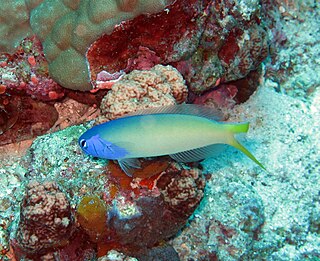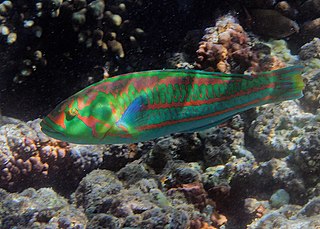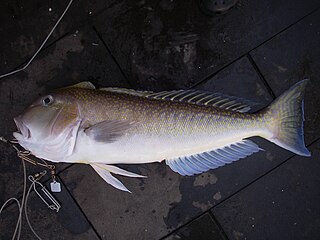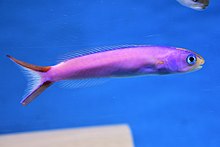
Tilefishes are mostly small perciform marine fish comprising the family Malacanthidae. They are usually found in sandy areas, especially near coral reefs. They have a long life span, up to 46 years (females) and 39 years (males).

Hoplolatilus starcki, Stark's tilefish, purple-headed sand tilefish or bluehead tilefish, is a species of marine ray-finned fish, a tilefish belonging to the family Malacanthidae. This species is native to the central Indo-Pacific.

Hoplolatilus marcosi, the redback sand tilefish, is a species of marine ray-finned fish, a tilefish belonging to the family Malacanthidae. It is native to the western central Pacific Ocean.

The surge wrasse, also known as the green-blocked wrasse, purple wrasse or red and green wrasse, is a species of wrasse native to the southeast Atlantic Ocean through the Indian and Pacific Oceans, where it inhabits reefs and rocky coastlines in areas of heavy wave action at depths from the surface to 10 m (33 ft). This species is of minor importance to local commercial fisheries, is popular as a game fish, and can be found in the aquarium trade.

The ocean whitefish, also known as the ocean tilefish, is a species of marine ray-finned fish, a tilefish belonging to the family Malacanthidae. It is native to the eastern Pacific Ocean.

Caulolatilus cyanops, the blackline tilefish or ocean whitefish, is a species of marine ray-finned fish, a tilefish belonging to the family Malacanthidae. It is found in the western Atlantic Ocean.

The Gulf bareye tilefish, also known as the anchor tilefish, is a species of marine ray-finned fish, a tilefish belonging to the family Malacanthidae. It occurs in the western Atlantic Ocean.

Branchiostegus japonicus, the horsehead tilefish, Japanese horsehead tilefish, red amadai or the red tilefish, is a species of marine ray-finned fish, a tilefish belonging to the family Malacanthidae. It is native to the western Pacific Ocean.

The great northern tilefish or golden tile, is the largest species in the family Malacanthidae (tilefishes). It grows to a length of between 38 and 44 inches. The great northern tilefish is a slow-growing and long-lived species that has four stages of life. After hatching from eggs, the larvae are found in plankton. As they grow into juveniles, the individuals seek shelter until finding or making their own burrows. As adults, the tilefish continue to expand their burrows in the sediment throughout their lives. The diet of the larvae is unknown, but presumed to consist of zooplankton; juveniles and adults feed upon various benthic invertebrates, crustaceans, and fish. After reaching sexual maturity between 5 and 7 years of age, females lay eggs throughout the mating season for the male to fertilize, with each female laying an average of 2.3 million eggs.

The blue blanquillo, also known as the banded blanquillo, striped blanquillo, false whiting, sand tilefish or eye of the sea, is a species of marine ray-finned fish, a tilefish belonging to the family Malacanthidae. It is found in the Indo-Pacific.

Branchiostegus is a genus of marine ray-finned fishes, tilefishes, belonging to the family Malacanthidae. They are found in the eastern Atlantic Ocean through the Indian Ocean to the western Pacific Ocean. Here they create burrows in soft substrates in the comparatively deep waters of the continental shelf and slope.

Caulolatilus is a genus of tilefishes native to the Pacific and Atlantic coasts of the Americas. This genus is regarded as the least specialised and the most basal of the tilefishes.

Hoplolatilus is a genus of tilefishes native to the Indian Ocean and the western Pacific Ocean. The chameleon tilefish (Hoplolatilus chlupatyi), also known as the flashing tilefish, is well known in particular in the aquarium hobby due to its unique ability to change colors in an instant with the help of specialized proteins in its skin that can reflect light in different wavelengths, allowing it to cycle between primary and secondary colors on the light spectrum.

Lutjanus purpureus, the southern red snapper or Caribbean red snapper, is a species of marine ray-finned fish, a snapper belonging to the family Lutjanidae. It is native to the western Atlantic Ocean as well the Caribbean Sea.

Malacanthus plumieri, the sand tilefish, is a species of marine ray-finned fish, a tilefish belonging to the family Malacanthidae. It is found in the western Atlantic Ocean.
Branchiostegus albus, is a species of marine ray-finned fish, a tilefish belonging to the family Malacanthidae. It is native to the Northwest Pacific, from southern Japan to the East China Sea. This species reaches a length of 45 cm (18 in).
Branchiostegus saitoi, is a species of marine ray-finned fish, a tilefish belonging to the family Malacanthidae. It is found in the Philippines. This species reaches a length of 32.9 cm (13.0 in).
Branchiostegus serratus, the Australian barred tilefish, is a species of marine ray-finned fish, a tilefish belonging to the family Malacanthidae. It is found in eastern Australia. This species reaches a length of 28.5 cm (11.2 in).

Branchiostegus sawakinensis, the freckled tilefish, is a species of marine ray-finned fish, a tilefish belonging to the family Malacanthidae. It is native to the Indo-West Pacific area. From the Red Sea and south off Durban, South Africa. Also reported from the Arafura Sea, found in northwestern Australia and around the Philippines. This species reaches a length of 45 cm (18 in).

Hoplolatilus fourmanoiri, commonly known as the yellow-spotted tilefish, is a species of marine ray-finned fish, a tilefish belonging to the family Malacanthidae.















